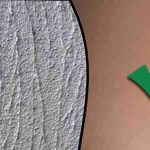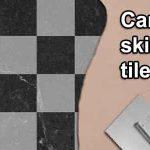There are many reasons you may want to replace floorboards. These could be cosmetic, such as adding new exposed wood flooring. You could be accessing pipes or electric cables. Or it could be for more serious issues, such as replacing boards that have been damaged, by things like rot and woodworm.
Whatever your reasons for removing the floorboards, the process is usually quite easy. Just pull the old boards up and replace them. However, it Is not always this simple. One problem you may come across is floorboards running under an internal wall.
Floorboards will often run under partition walls. This happens because the wall was built after the flooring was laid.
The main problem occurs when a wall is built parallel to the joists below it. In this scenario, floorboards will run across the joists at 90°. They will also be running at 90° with the wall, and as the wall was built after the floorboards were installed, the boards will run straight under the wall.
This can cause problems if you need to replace your floorboards, as they can be very difficult to remove. You also need to consider, that they are offering some level of support to the wall above them.
How to remove floorboards under a wall

The first thing you need to consider, is why you are removing the floorboards in the first place. If you are simply trying to access pipes or cables below, you can probably just cut out a few sections of floorboard to gain access.
If at all possible, you should cut these back to the nearest joist, this way you will not remove any of the support from below the wall. Also, if you’re on an upper floor, you could consider accessing any plumbing and electrics from below. This would mean, you don’t need to remove any flooring at all. Obviously, this would require some repair work to the ceiling following any work.
In modern properties, current building regulations for internal walls state that any wall built parallel with joists should have a double joist running underneath as support. This may be more substantial for masonry walls (as they are heavier).
However, in older properties, this may not always be the case. You may still find a joist under the wall, but it is not uncommon for them to just sit on top of floorboards between two joists, especially if it is a timber stud wall.
If the wall is sat on a double joist, you may be able to simply cut the boards back to the wall. Once this has been done, you can simply run up to the wall with new boards. You may need to fix another timber to the joist to carry the boards. This could be something like a 3×2 screwed or bolted to the joist. Once this is fixed in place you will have support for the end of your new boards to sit on.
If the wall sits on a single joist, you could potentially double the joist up, this will improve structural strength and provide somewhere to fix the end of your boards.
The goal here is to have an exposed timber ledge for the end of your floorboards to sit on.
Problems you may face removing entire floorboards
If you do need to remove entire boards, maybe even all of your floorboards, you will have some issues to contend with. You may need to remove whole boards if there have been issues with things like rot, or woodworm infestation. In these instances, the whole board will need to go, in order to avoid future issues.
Potential problem #1
The first issue is that you need to maintain a good level of support for your wall. You can’t just remove the entire floor in one go.
If you remove all the floorboards at once, the wall won’t be sat on anything. This is because the floorboards fill a space between the bottom of the wall and the joists. Also, there is a chance, that there is no joist below, in which case, your wall would have literally nothing below it.
The boards may only be an inch or less thick, but they do offer a lot of support to the wall. This means you need to remove and replace your floorboards in sections.
Ideally, you would remove a few boards at a time and then replace them before you proceed with the next few boards. This can be tedious, but it will ensure your wall remains supported
Potential problem #2
Whilst this may sound simple, it probably won’t be as easy as just sliding the boards out. The floorboards will be fixed in place (often nailed) and the wall will be fixed through the boards and into the joists below.
If the joist is being completely replaced, you can cut them back to the wall and then remove the floorboard on either side. Following this use a bolster or a rough wood chisel to remove the last section of floorboard below the wall. If the timber is rotten or deteriorated, this might be quite easy. If the board is tougher, you can try chiselling down the grain. This will help you split the boards around the fixings.
Once the last bit of timber floorboard is out, you should just be left with the fixings. How you deal with this, will depend on the type of fixings.
For old nails, there is a good chance you can snap them with a bolster. For newer nails and screws you will probably need to cut them with a hack saw. Either way, you should try to remove any protruding or rough edges, as this could scratch your new boards as you feed them in.
Once you have removed 3-4 boards and ensured the fixings are completely removed, you can start to feed in some new floorboards. Once these are in place. Move onto the next few boards and repeat the process.
Do you need help removing floorboards under a wall?
This is definitely not a job for a novice DIY’er. It does have some minor structural implications. Therefore, if you are in any doubt at all, you should definitely talk with a professional.
To ensure the highest quality of work and the best possible price, we recommend comparing local quotes. The easiest way to do this is via a comparison website.
These types of websites offer several advantages, including:
- The Business is verified by the comparison site
- Past customer reviews can be viewed
- You can view similar work they have done
- Businesses are competing for the same job, so prices can be heavily discounted
We have seen discounts as high as 50% on this type of comparison site. Also, because the workers are verified and reviewed, you know you are hiring a high-quality trade person and not a cowboy.
Conclusion
Removing floorboards is usually a simple process. However, when they run under existing partition walls, this adds a whole new level of complexity.
Hopefully, the example given in this article gives you some ideas of how to tackle it. But if you are unsure, this is definitely a job, where a professional might be required to ensure the best result. There are quite a lot of ifs and buts, to this type of job. The processes mentioned above are certainly not a one size fits all solution. Therefore, different scenarios may require the help of an experienced carpenter




